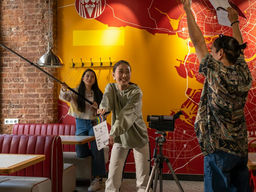Sergei Eisenstein and the Montage
- Siddhartha Chakraborty

- Aug 3, 2020
- 3 min read
Updated: Sep 2, 2020
Sergei Eisenstein is one of the most important people in the history of Film making. Eisenstein was a Soviet Filmmaker, Editor, and Film theorist. We say Film making is an art as well as Science, Science because of men like Eisenstein, Kulshov, Vertov, and many more.

In the early 1920s Russia was going through Civil war, and amidst that due to lack of availability of Film reels the Russian filmmakers started Studying films and first Film School was set up, with Lev Kuleshov one of the first Film Teacher, While Other Filmmakers were excited to bring Theater on-screen, Eisenstein thought of film making not as a theater or painting but as a language. He was one of the few to realize that Film can compress time as well as expand time.
According to Eisenstein Language was much closer to Cinema then painting. While Studying Films, he carefully studied the duration of cuts, and how the shots were arranged, and developed a theory ‘Montage’
Montage is a film editing technique in which a series of short shots are sequenced to condense space, time, and information.
There are 5 types of Montages –
Metric Montage
Rhythmic Montage
Tonal Montage
Overtonal Montage
Intellectual Montage
Even in a less exaggerated description, any verbal account of a person is bound to find itself employing an assortment of waterfalls, lightning rods, landscapes, birds, etc. Sergei Eisenstein
Eisenstein believed that the more the conflicting the shots are the more it is intellectual leaving its audience in shock which also stirs their inner emotions.
Eisenstein’s second feature film Battleship Potempkein is named one of the most important films, the greatest film and must watch the film for film students. The Odessa Sequence from the film is an almost 10-minute long sequence and is a study of various Montages.
Over the 100 years montage has changed its course and meaning, but the main sub idea remains the same. According to Sergei Eisenstein’s Montage was a way of editing or intellectual process, Montage in a way tells a story and Intellectual Montage may be conflicting as what one person perceives, others may think the different. The five main classifications of montages were,
Metric Montage – where the editing follows a specific number of frames, cutting to the next shot no matter what is happening within the image. This montage is used to elicit the most basal and emotional reactions in the audience. Metric montage was based on the absolute length of shots.
Rhythmic Montage – Rhythmic montage seeks an editorial and compositional relationship in which movements within frames are as important as lengths of shots. The complexity that was cautioned against for metric montage is praised for rhythmic. Since the content of the shot is a dominant element of the short length, the ascending or descending meter of the shots makes intuitive visual sense.
Tonal Montage – a tonal montage uses the emotional meaning of the shots, not just manipulating the temporal length of the cuts or its rhythmical characteristics, to elicit a reaction from the audience even more complex than from the metric or rhythmic montage. For example, a sleeping baby would emote calmness and relaxation.
Overtonal Montage – the over tonal montage is the cumulation of metric, rhythmic, and tonal montage to synthesize its effect on the audience for an even more abstract and complicated effect.
Intellectual Montage – uses shots which, combined, elicit an intellectual meaning. Intellectual montage seeks to use a few images, but images that are rich in cultural, symbolic, and political history. Their collision brings about complex concepts that traditional montage could not achieve. For example in the Apocalypse Now by Francis Ford Coppola execution of Colonel Kurtz is juxtaposed with the villagers’ ritual slaughter of a water buffalo.
Many directors have used in past combination of Metric, Rhythmic and Tonal Montage to beautifully create a scene, For example, the End Sequence of Mexican standoff between The Good, The Bad, and the Ugly in the film The Good, The Bad, and the Ugly all three Montages were used.
Over time the meaning of Montage has changed, today the montage is a series of shots in no particular order to condense the space and time. From the 1930s to the 1950s, montages were usually used to symbolize transportation across long distances or the change in times through newsreels. Be it Rocky’s Training or Montage sequence from UP, or the last monologue in American Beauty, Montage has captured the beauty of storytelling by extending the time or shortening. But the main Principle of Soviet Montage Theory still remains, The Shot arranged in a way to tell the stories.











Comments